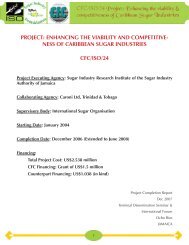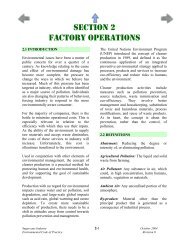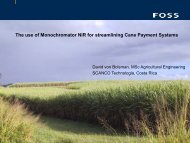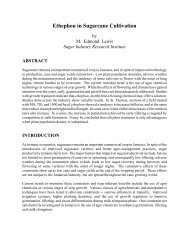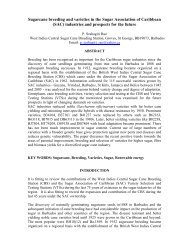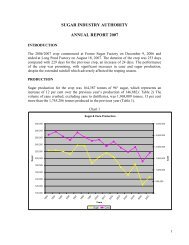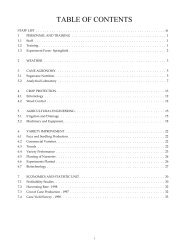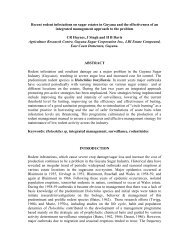The Effects of Ethrel as a Flowering Inhibitor in Sugarcane
The Effects of Ethrel as a Flowering Inhibitor in Sugarcane
The Effects of Ethrel as a Flowering Inhibitor in Sugarcane
Create successful ePaper yourself
Turn your PDF publications into a flip-book with our unique Google optimized e-Paper software.
THE EFFECTS OF ETHREL AS A FLOWERING INHIBITOR IN SUGARCANE<br />
By<br />
A. PARK, L. SHIVRAJ, P. DAVIS, A. D. Dey and M. Cumm<strong>in</strong>gs<br />
Guyana Sugar Corporation Incorporated, Agriculture Research Centre<br />
Abstract<br />
Two experiments were conducted to determ<strong>in</strong>e the retardation effect <strong>of</strong> <strong>Ethrel</strong> (1L/ha) on<br />
flower<strong>in</strong>g and the possible reduction <strong>in</strong> sugar <strong>as</strong> a result <strong>of</strong> flower<strong>in</strong>g <strong>of</strong> canes.<br />
One trial comprised a split-plot design with three cane varieties and three different tim<strong>in</strong>gs <strong>of</strong><br />
<strong>Ethrel</strong> application replicated three times. <strong>Ethrel</strong> w<strong>as</strong> applied when canes were 19, 20 and 21 weeks<br />
old respectively. <strong>The</strong> second trial consisted <strong>of</strong> one variety, which w<strong>as</strong> planted at eight different<br />
estate locations with <strong>Ethrel</strong> applied at approximately 14 –18 weeks post-plant<strong>in</strong>g. In this trial, a<br />
Plant Growth Regulator (PGR) namely Evergreen w<strong>as</strong> <strong>in</strong>cluded <strong>in</strong> comb<strong>in</strong>ation with <strong>Ethrel</strong> <strong>as</strong> one<br />
<strong>of</strong> the treatments to possibly counteract the <strong>as</strong>sumed negative impact on plant growth from <strong>Ethrel</strong>.<br />
Results <strong>of</strong> the impact <strong>of</strong> the treatments on flower<strong>in</strong>g <strong>in</strong>tensity, cane length and girth, sugarcane<br />
quality and cane yields are presented. Both sets <strong>of</strong> trials have <strong>in</strong>dicated that timely application <strong>of</strong><br />
<strong>Ethrel</strong> can delay the onset <strong>of</strong> flower<strong>in</strong>g by <strong>as</strong> much <strong>as</strong> 4 weeks and result <strong>in</strong> floral <strong>in</strong>hibition <strong>of</strong> the<br />
order 15-32% <strong>in</strong> heavy flower<strong>in</strong>g varieties.<br />
KEYWORDS: <strong>Flower<strong>in</strong>g</strong> <strong>in</strong>tensity, <strong>in</strong>hibition, <strong>Ethrel</strong>.
INTRODUCTION<br />
<strong>The</strong>se trials were undertaken to <strong>as</strong>sess the potential for improv<strong>in</strong>g flexibility <strong>of</strong> the plant<strong>in</strong>g time<br />
for varieties that flower, <strong>as</strong> well <strong>as</strong> be<strong>in</strong>g able to select varieties that may otherwise be highyield<strong>in</strong>g,<br />
pest, dise<strong>as</strong>e and lodg<strong>in</strong>g resistant but would have been rejected due to their flower<strong>in</strong>g<br />
characteristics.<br />
<strong>Flower<strong>in</strong>g</strong> <strong>in</strong> sugarcane is a complex physiological process consist<strong>in</strong>g <strong>of</strong> multiple stages <strong>of</strong><br />
development, each stage hav<strong>in</strong>g specific environmental and physiological requirements. For<br />
example, if the specific day length, temperature and moisture requirements are not satisfied,<br />
flower<strong>in</strong>g is <strong>in</strong>hibited or the <strong>in</strong>tensity is reduced. Under natural conditions, a day length be<strong>in</strong>g<br />
fixed at any given latitude and date, it is essentially the location (altitude), temperature, moisture<br />
stress and the nutrition level that affect the tim<strong>in</strong>g and <strong>in</strong>tensity <strong>of</strong> flower<strong>in</strong>g (Nayamuth et al.,<br />
2003).<br />
<strong>The</strong> prevention <strong>of</strong> arrow<strong>in</strong>g and the consequent economic losses result<strong>in</strong>g from flower<strong>in</strong>g to be<br />
achieved on a commercial scale is not fe<strong>as</strong>ible by means <strong>of</strong> photoperiod manipulation. Hence, the<br />
need for chemical floral <strong>in</strong>hibitors like <strong>Ethrel</strong>. <strong>Ethrel</strong> w<strong>as</strong> demonstrated to delay open<strong>in</strong>g <strong>of</strong> the<br />
<strong>in</strong>florescence <strong>of</strong> flagg<strong>in</strong>g canes (E<strong>as</strong>twood and Davis, 1997). Other applications <strong>in</strong>clude reduction<br />
<strong>of</strong> vegetation growth (cereals) to flower <strong>in</strong>duction (p<strong>in</strong>eapples) or <strong>in</strong>hibition (sugarcane). It also<br />
promotes the whole complex ripen<strong>in</strong>g process <strong>in</strong>clud<strong>in</strong>g anthocyan<strong>in</strong> synthesis (fruits) and<br />
dehiscence.<br />
<strong>The</strong> plant physiological activity <strong>of</strong> Ethephon w<strong>as</strong> discovered <strong>in</strong> the mid sixties and s<strong>in</strong>ce then an<br />
impressive amount <strong>of</strong> work h<strong>as</strong> been carried out with regard to its mode <strong>of</strong> action and practical<br />
applications <strong>in</strong> agriculture (Rhone-Poulenc, 1990).<strong>Ethrel</strong> or Ethephon (2-chloroethyl phosphonic<br />
acid) is rapidly metabolized <strong>in</strong> plants, soils and animals via hydrolysis, produc<strong>in</strong>g ethylene g<strong>as</strong>,<br />
phosphoric acid and hydrochloric acid; these breakdown products are not toxic and are found<br />
naturally <strong>in</strong> all plants.
MATERIALS AND METHODS<br />
Experiment 1<br />
This experiment w<strong>as</strong> conducted <strong>in</strong> the Agriculture Research Centre (ARC) field located at the La<br />
Bonne Intention (LBI) estate location. <strong>The</strong> trial comprised a split-plot design <strong>in</strong> a factorial<br />
arrangement. <strong>The</strong> ma<strong>in</strong> plot comprised <strong>of</strong> three “heavy flower<strong>in</strong>g” varieties D 93409, D 15841 and<br />
WI79463 (factor A) planted <strong>in</strong> plots 4 rows X 7.2 m with the sub plot be<strong>in</strong>g the three applications<br />
<strong>of</strong> ethrel at one week <strong>in</strong>tervals commenc<strong>in</strong>g July 12 th 2007 (factor B) at a rate <strong>of</strong> 940 mL/hectare.<br />
<strong>The</strong>se canes were planted <strong>in</strong> early March 2007 dur<strong>in</strong>g the first crop. <strong>Ethrel</strong> (Ethephon) [2-<br />
chloroethyl phosponic acid, 48% w/v) w<strong>as</strong> applied at the different times (12 th to 26 th July) us<strong>in</strong>g a<br />
knapsack sprayer. Growth stations were established (two 1m-rows <strong>in</strong> each treatment) and monthly<br />
growth parameters me<strong>as</strong>ured from 36 weeks to emergence <strong>of</strong> panicle. Brix values were determ<strong>in</strong>ed<br />
fortnightly up until anthesis us<strong>in</strong>g a hand-held digital refractometer. Flower <strong>in</strong>tensity w<strong>as</strong><br />
<strong>as</strong>sessed just prior to harvest.<br />
Experiment 2<br />
This w<strong>as</strong> an unreplicated study conducted <strong>in</strong> a s<strong>in</strong>gle field and repeated at eight different locations.<br />
Canes <strong>in</strong> this trial w<strong>as</strong> also planted <strong>in</strong> March dur<strong>in</strong>g the first crop and <strong>Ethrel</strong> w<strong>as</strong> applied once only<br />
at 940 mls per hectares dur<strong>in</strong>g the period late June to early July when canes were approximately<br />
13 to 17 weeks old. Evergreen 7-7-7, a plant growth regulator and bio-fertilizer compris<strong>in</strong>g 7%<br />
each <strong>of</strong> the elements nitrogen (N), phosphorus (P) and pot<strong>as</strong>sium (K) w<strong>as</strong> also <strong>in</strong>cluded <strong>in</strong> one<br />
treatment to counteract the <strong>as</strong>sumed negative impact <strong>of</strong> <strong>Ethrel</strong> on plant growth.<br />
<strong>The</strong> three treatments evaluated were (i) control (no Ethephon or Evergreen applied), (ii) Ethephon<br />
applied at 1.0 L/ha and (iii) Ethephon and Evergreen applied at 1.0 L/ha and 2.0 L/ha respectively.<br />
Applications <strong>of</strong> <strong>Ethrel</strong> were done towards the end <strong>of</strong> June or early July us<strong>in</strong>g the aircraft where<strong>as</strong><br />
the Evergreen w<strong>as</strong> applied at the same time with knapsack sprayers. <strong>The</strong> variety used <strong>in</strong> this study<br />
w<strong>as</strong> ma<strong>in</strong>ly D15841 with the exception <strong>of</strong> the Skeldon location which used D 93409.<br />
Plant growth me<strong>as</strong>urements commenced when canes were approximately 4 months old, while<br />
flower <strong>in</strong>tensity <strong>as</strong>sessments were done fortnightly from the time <strong>of</strong> flower <strong>in</strong>itiation up until<br />
harvest; brix me<strong>as</strong>urements conducted on the 5 th <strong>in</strong>ternode from the top <strong>of</strong> the stalk commenced at<br />
40 weeks and were repeated at 2 week <strong>in</strong>tervals up to harvest. Gross cane yields (t/ha.) were<br />
determ<strong>in</strong>ed at harvest.
RESULTS AND DISCUSSION<br />
Experiment 1<br />
<strong>Flower<strong>in</strong>g</strong> Intensity<br />
Statistical analysis <strong>of</strong> the data <strong>in</strong>dicated no significant (P >0.05) <strong>in</strong>teraction effect <strong>in</strong> flower<strong>in</strong>g<br />
<strong>in</strong>tensity between cane variety and tim<strong>in</strong>g <strong>of</strong> application <strong>of</strong> <strong>Ethrel</strong>. <strong>The</strong>re were however significant<br />
differences <strong>in</strong> flower<strong>in</strong>g <strong>in</strong>tensity (averaged over varieties) for the different <strong>Ethrel</strong> application<br />
tim<strong>in</strong>gs (Table 1a). <strong>Ethrel</strong> applied on the 19 th and 26 th July gave 32 and 15 percent reductions <strong>in</strong><br />
flower<strong>in</strong>g respectively.<br />
<strong>Flower<strong>in</strong>g</strong> <strong>in</strong>tensity values for the various varieties (averaged over all application periods) were<br />
not significantly different (Table 1b).<br />
Brix Read<strong>in</strong>gs<br />
Mean field-brix values showed no significant (P > 0.05) <strong>in</strong>teraction effect between <strong>Ethrel</strong><br />
application periods and the various cane varieties. At each stage <strong>of</strong> me<strong>as</strong>urement, the brix values<br />
<strong>of</strong> the <strong>Ethrel</strong>-treated canes were not significantly (P > 0.05) different from those <strong>of</strong> the control<br />
treatment (Figs 1a). However, mean brix values (averaged over application periods) were<br />
significantly (P
15841 and WI79463 respectively. This low recorded cane yield for D 15841 corresponds with the<br />
lack <strong>of</strong> reduction <strong>of</strong> the flower<strong>in</strong>g <strong>in</strong>tensity with the application <strong>of</strong> <strong>Ethrel</strong>.<br />
Experiment 2<br />
<strong>Flower<strong>in</strong>g</strong> Intensity<br />
Maximum flower<strong>in</strong>g <strong>in</strong>tensity varied for the different trial locations (Table 2a). <strong>The</strong> mean<br />
maximum value for the control plots (averaged across the locations) w<strong>as</strong> 59.6% and ranged from<br />
97.6% at Albion (AN) to 19.8% at LBI. <strong>The</strong> mean maximum value (averaged across the locations)<br />
for the comb<strong>in</strong>ed treatments <strong>of</strong> <strong>Ethrel</strong>-treated canes w<strong>as</strong> 46.6% and ranged from 93.4% at AN to<br />
8.2% at Wales (GV).<br />
<strong>The</strong> effect <strong>of</strong> <strong>Ethrel</strong> <strong>in</strong> reduc<strong>in</strong>g flower<strong>in</strong>g <strong>in</strong> canes (Table 2b) w<strong>as</strong> observed at all the locations<br />
with the exception <strong>of</strong> Blairmont (BCF). <strong>The</strong> percentage reduction <strong>in</strong> flower<strong>in</strong>g from <strong>Ethrel</strong> use<br />
varied for the different locations and ranged from a high <strong>of</strong> 80% at Wales to a low <strong>of</strong> 0.0% at<br />
Blairmont. Overall, there w<strong>as</strong> a 22% to 27% reduction <strong>in</strong> flower<strong>in</strong>g (averaged over the locations)<br />
attributed to the use <strong>of</strong> <strong>Ethrel</strong>.<br />
Brix Read<strong>in</strong>gs<br />
Brix read<strong>in</strong>gs for the various treatments taken just prior to harvest at ages rang<strong>in</strong>g from 44 weeks<br />
to 50 weeks are outl<strong>in</strong>ed <strong>in</strong> table 3. <strong>The</strong>re were generally no significant (P > 0.05) differences <strong>in</strong><br />
brix read<strong>in</strong>gs at this late stage <strong>of</strong> test<strong>in</strong>g among the various treatments at any <strong>of</strong> the trial locations,<br />
<strong>in</strong>dicat<strong>in</strong>g no significant negative impact <strong>of</strong> <strong>Ethrel</strong> on the quality <strong>of</strong> canes. Mean Brix values<br />
(across the locations) 20.0, 19.5 and 21.5 for the control, <strong>Ethrel</strong> only and <strong>Ethrel</strong> plus Evergreen<br />
treatments respectively.<br />
Growth Me<strong>as</strong>urements<br />
Me<strong>as</strong>urements <strong>of</strong> stalk height and girth (circumference) were done at vary<strong>in</strong>g time <strong>in</strong>tervals fat the<br />
different trial locations. However, only the latest me<strong>as</strong>urements for each location are reported<br />
here. <strong>The</strong>se me<strong>as</strong>urements were done when canes were between the ages <strong>of</strong> 34 and 45 weeks old.<br />
Me<strong>as</strong>urements <strong>of</strong> stalk height showed significant (P < 0.05) differences among the treatments at<br />
two locations only, Blairmont and Enmore. At these locations the stalks <strong>of</strong> <strong>Ethrel</strong>-treated canes<br />
were significantly shorter than those <strong>of</strong> the control plots <strong>in</strong>dicat<strong>in</strong>g that the application <strong>of</strong> <strong>Ethrel</strong><br />
may have retarded the growth <strong>of</strong> canes. However, the suggested stimulat<strong>in</strong>g effect <strong>of</strong> Evergreen<br />
application on cane growth w<strong>as</strong> not evident (Table 4a).
Me<strong>as</strong>urements <strong>of</strong> stalk girth showed no significant (P > 0.05) differences among the treatments at<br />
any <strong>of</strong> the locations (Table 4b).<br />
Cane Yields<br />
Plant cane yields at harvest showed great variation for the different locations (Table 5). In only<br />
two trials, at Enmore and Uitvlugt were there substantial reductions <strong>in</strong> cane yields between the<br />
<strong>Ethrel</strong>-treated and the untreated canes, which might lend credence to the view that the application<br />
<strong>of</strong> <strong>Ethrel</strong> to canes can negatively impact cane yields.Tthe more common experience is that <strong>Ethrel</strong><br />
applications stimulate tiller<strong>in</strong>g at early stages <strong>of</strong> grow or <strong>in</strong>itiate fresh growth <strong>in</strong> <strong>in</strong>dividual stalks<br />
applied at later growth stages ( after an <strong>in</strong>itial period <strong>of</strong> growth suppression). Cane yields are<br />
typically enhanced <strong>in</strong> either c<strong>as</strong>e. This occurred at four locations (SWR, RH, LBI and GV) with<br />
the enhanced effect on yield <strong>as</strong>sociated with the <strong>Ethrel</strong> + Evergreen treatment two out <strong>of</strong> the four<br />
times.
GENERAL DISCUSSIONS AND CONCLUSIONS<br />
Evans and Bates (1966) suggested that the vagaries <strong>of</strong> the degree and tim<strong>in</strong>g <strong>of</strong> sugarcane<br />
flower<strong>in</strong>g <strong>in</strong> Guyana can be expla<strong>in</strong>ed by exam<strong>in</strong><strong>in</strong>g the ra<strong>in</strong>fall data from the end <strong>of</strong> the previous<br />
year through to the mid year ra<strong>in</strong>s <strong>of</strong> the current year. Figure 2 illustrates the variation <strong>in</strong> ra<strong>in</strong>fall<br />
obta<strong>in</strong>ed at the different locations from September 2006 to December 2007. P. H. Moore (1985)<br />
suggested that flower<strong>in</strong>g <strong>in</strong> canes is dependent on the comb<strong>in</strong>ed effects <strong>of</strong> moisture and<br />
temperature, which are closely related. High ra<strong>in</strong>fall is <strong>as</strong>sociated with <strong>in</strong>cre<strong>as</strong>ed cloud cover,<br />
produc<strong>in</strong>g a lower daylight maximum temperature and a higher m<strong>in</strong>imum night temperature.<br />
<strong>The</strong>refore, observations on flower<strong>in</strong>g <strong>in</strong>tensity attributable to one <strong>of</strong> these environmental factors<br />
may, <strong>in</strong> fact, be the result <strong>of</strong> the other or to an <strong>in</strong>teraction <strong>of</strong> the two. It is commonly observed that<br />
moist, cloudy weather favors flower<strong>in</strong>g while hot, dry weather reduces flower<strong>in</strong>g. In other are<strong>as</strong>,<br />
<strong>in</strong>cre<strong>as</strong>ed flower<strong>in</strong>g is <strong>as</strong>sociated with high water tables or with soils hav<strong>in</strong>g a high soil moisture<br />
content. Decre<strong>as</strong>ed ra<strong>in</strong>fall or reduced irrigation dur<strong>in</strong>g the month preced<strong>in</strong>g <strong>in</strong>duction commonly<br />
reduces the percent flower<strong>in</strong>g.<br />
As <strong>in</strong> Mauritius, where flower<strong>in</strong>g occurred at all sites, the percentage <strong>of</strong> flowered varieties and the<br />
flower<strong>in</strong>g <strong>in</strong>tensity differed widely between years for the same environment and between<br />
environments for the same year (Nayamuth et al., 2003).<br />
Results from the two different sets <strong>of</strong> experiments conducted <strong>in</strong> Guyana <strong>in</strong>dicated great variation<br />
<strong>in</strong> flower<strong>in</strong>g <strong>in</strong>tensities. <strong>The</strong> general observations were that canes treated with <strong>Ethrel</strong> showed<br />
reduced flower<strong>in</strong>g <strong>in</strong>tensity compared with untreated canes, while the amount <strong>of</strong> reduction varied<br />
from 0.0% to <strong>as</strong> much at 80%. Mean percentage reduction <strong>in</strong> flower<strong>in</strong>g obta<strong>in</strong>ed <strong>in</strong> the two<br />
experiments were 15 to 32% and 22 to 27% respectively.<br />
Plant growth parameters were not greatly affected by the application <strong>of</strong> <strong>Ethrel</strong> when applied to<br />
<strong>in</strong>hibit flower<strong>in</strong>g and neither were juice quality and plant cane yields.<br />
Table 1a: Percentage flower<strong>in</strong>g <strong>in</strong>tensity for canes treated with <strong>Ethrel</strong> at different dates<br />
Date/age <strong>of</strong> <strong>Ethrel</strong> application <strong>Flower<strong>in</strong>g</strong> <strong>in</strong>tensity (%) Flower reduction (%)<br />
Control 62.6 -<br />
12 th July (19 wks old) 42.5 32.1<br />
19 th July (20 wks old) 53.3 14.9<br />
26 th July (21 wks old) 64.4 + 2.9
Table 1b: Percentage flower<strong>in</strong>g <strong>in</strong>tensity for different varieties treated with <strong>Ethrel</strong><br />
Cane Variety <strong>Flower<strong>in</strong>g</strong> <strong>in</strong>tensity (%) Flower reduction (%)<br />
D 93409 48.4 21.0<br />
D 15841 45.1 0.0<br />
WI79463 73.5 + 18.2<br />
Table 2a: Maximum flower<strong>in</strong>g <strong>in</strong>tensity (%) atta<strong>in</strong>ed at the different locations<br />
Treatment Skeldon Albion Rose Hall Blairmont Enmore LBI Wales Mean<br />
Control 72.1 97.6 94.5 56.9 35.0 19.8 41.3 59.6<br />
<strong>Ethrel</strong> 47.6 93.4 77.8 59.3 23.1 16.8 8.2 46.6<br />
Table 2b: <strong>Flower<strong>in</strong>g</strong> retardation (%) at the different locations<br />
Estate Location Flower Retardation (%)<br />
Skeldon (SWR) 34.0<br />
Albion (AN) 4.3<br />
Rose hall (RH) 17.7<br />
Blairmont (BCF) 0.0<br />
Enmore (EHP) 34.0<br />
La Bonne Intention (LBI) 15.2<br />
Wales (GV) 80.1<br />
ICBU<br />
Not determ<strong>in</strong>ed<br />
Mean 26.5<br />
Table 3: Brix read<strong>in</strong>gs for the various treatments at the different locations<br />
T/ment SWR AN RH BCF EHP LBI GV ICBU Mean<br />
Control 18.7 17.0 19.3 22.2 20.0 21.7 19.1 20.0 19.8<br />
<strong>Ethrel</strong> 19.1 19.1 20.0 20.2 19.5 22.3 17.9 19.5 19.7<br />
<strong>Ethrel</strong> +<br />
Evergreen<br />
18.9 18.1 18.1 19.0 21.5 21.7 17.4 21.5 19.6<br />
Table 4a: Plant height (cm) for the various treatments at the different locations<br />
T/ment SWR AN RH BCF EHP LBI GV ICBU Mean<br />
Control 287 307 265 337 419 167 299 233 289<br />
<strong>Ethrel</strong> 287 328 281 305 259 183 286 221 269<br />
<strong>Ethrel</strong> + 283 307 277 319 264 188 287 254 272<br />
Evergreen<br />
Sig<br />
(P
Table 5: Cane Yield (MT/Ha) for the various treatments at the different locations<br />
T/ment SWR AN RH BCF EHP LBI GV ICBU Mean<br />
Control 94.9 85.5 72.5 98.1 108.0 42.2 88.0 69.7 82.36<br />
<strong>Ethrel</strong> 121.1 108.1 73.7 91.9 103.5 38.2 105.6 50.6 86.59<br />
<strong>Ethrel</strong> +<br />
Evergreen<br />
97.5 69.6 80.1 99.5 102.0 47.0 98.5 56.4<br />
81.33<br />
Fig 1a: Brix read<strong>in</strong>gs for different application dates<br />
20<br />
19.5<br />
19<br />
Brix<br />
18.5<br />
18<br />
17.5<br />
17<br />
46 48 50<br />
Age <strong>of</strong> cane (weeks)<br />
Control 12th July 19th July 26th July<br />
Fig 1b: Brix read<strong>in</strong>gs for the various varieties<br />
Brix<br />
21<br />
20<br />
19<br />
18<br />
17<br />
16<br />
15<br />
46 48 50<br />
Age <strong>of</strong> canes (weeks)<br />
D93409 D15841 WI179463
Fig 2: Monthly ra<strong>in</strong>fall for six <strong>of</strong> the trial-locations<br />
Note: <strong>The</strong> blue arrow <strong>in</strong>dicates when the canes were planted and the red arrow <strong>in</strong>dicates the time when the chemicals<br />
were applied.
REFERENCES<br />
E<strong>as</strong>twood, D and Davis, H.B. (1997) Chemical Ripen<strong>in</strong>g <strong>of</strong> sugarcane <strong>in</strong> Guyana. Progress and<br />
Prospects. Guyana Sugar Corporation Inc.<br />
Evans, H. and Bates, J.F. (1966) Some observations on the Incidence and Prevention <strong>of</strong><br />
<strong>Flower<strong>in</strong>g</strong> <strong>of</strong> <strong>Sugarcane</strong> <strong>in</strong> Guyana. Proc. Meet<strong>in</strong>g <strong>of</strong> the British West Indies Sugar Technologists.<br />
Nayamuth, R., Mangar, M and Soopaya, R. (2003). Characterization <strong>of</strong> Natural Environments<br />
for sugarcane flower<strong>in</strong>g ability.<br />
Moore, P.H.(1985) Saccharum. In:Halevey,A. H. (ed) CRC Handbook <strong>of</strong> <strong>Flower<strong>in</strong>g</strong>. Vol.4. CRC<br />
Press, Inc., Boca Raton, Florida, pp.243-262<br />
Rhone-Poulenc (1990) Technical Booklet.




